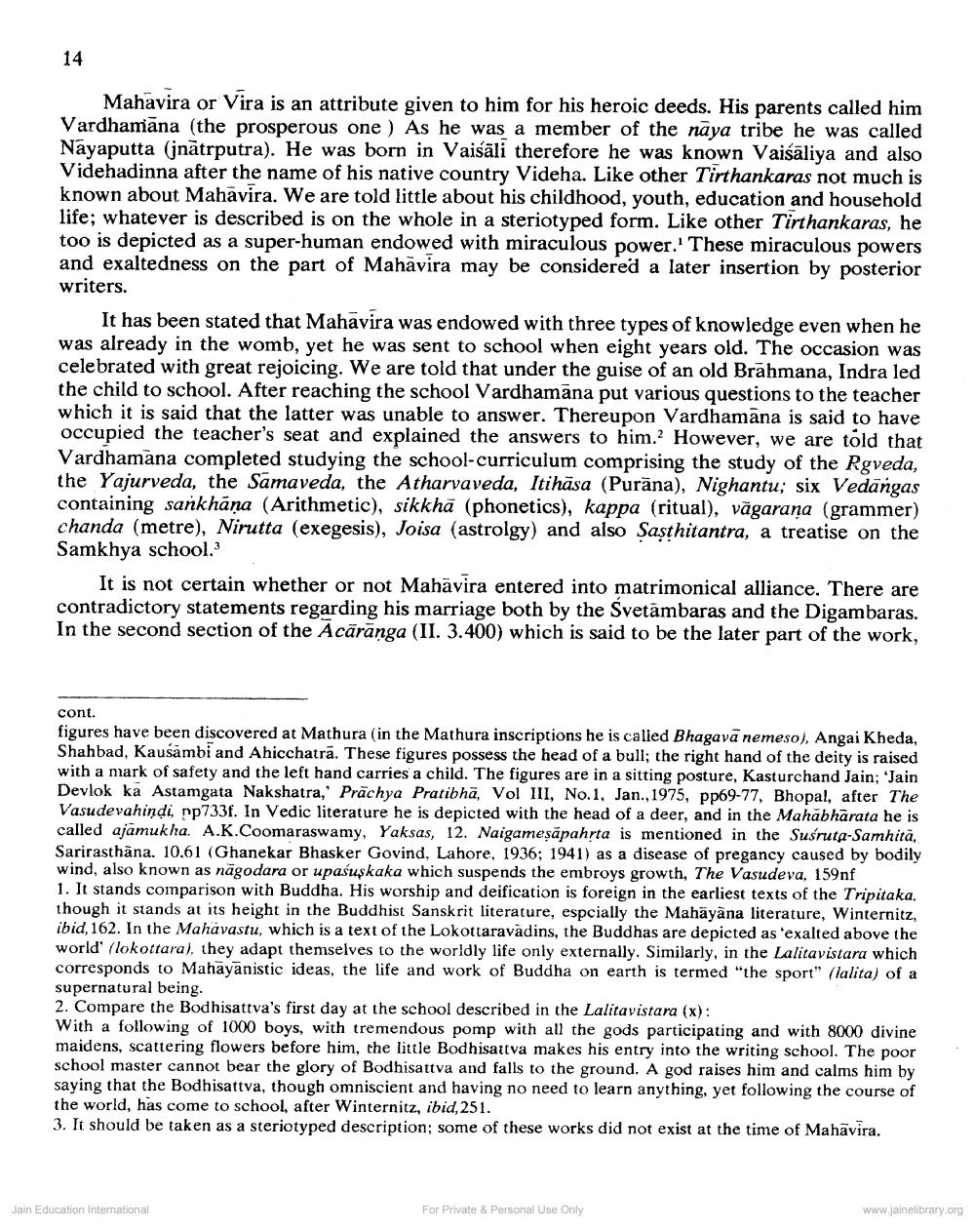________________
14
Mahavira or Vira is an attribute given to him for his heroic deeds. His parents called him Vardhamana (the prosperous one) As he was a member of the naya tribe he was called Nayaputta (nātrputra). He was born in Vaisāli therefore he was known Vaisaliya and also Videhadinna after the name of his native country Videha. Like other Tirthankaras not much is known about Mahavira. We are told little about his childhood, youth, education and household life; whatever is described is on the whole in a steriotyped form. Like other Tirthankaras, he too is depicted as a super-human endowed with miraculous power. These miraculous powers and exaltedness on the part of Mahavira may be considered a later insertion by posterior writers.
It has been stated that Mahavira was endowed with three types of knowledge even when he was already in the womb, yet he was sent to school when eight years old. The occasion was celebrated with great rejoicing. We are told that under the guise of an old Brahmana, Indra led the child to school. After reaching the school Vardhamāna put various questions to the teacher which it is said that the latter was unable to answer. Thereupon Vardhamana is said to have occupied the teacher's seat and explained the answers to him. However, we are told that Vardhamana completed studying the school-curriculum comprising the study of the Rgveda, the Yajurveda, the Samaveda, the Atharvaveda, Itihāsa (Purāna), Nighantu; six Vedangas containing sankhāna (Arithmetic), sikkhā (phonetics), kappa (ritual), văgarana (grammer) chanda (metre), Nirutta (exegesis), Joisa (astrolgy) and also Sasthitantra, a treatise on the Samkhya school.3
It is not certain whether or not Mahavira entered into matrimonical alliance. There are contradictory statements regarding his marriage both by the Svetāmbaras and the Digambaras. In the second section of the Acārānga (II. 3.400) which is said to be the later part of the work,
cont. figures have been discovered at Mathura (in the Mathura inscriptions he is called Bhagavā nemeso), Angai Kheda, Shahbad, Kausambi and Ahicchatrā. These figures possess the head of a bull; the right hand of the deity is raised with a mark of safety and the left hand carries a child. The figures are in a sitting posture, Kasturchand Jain; 'Jain Devlok ka Astamgata Nakshatra, Prächya Pratibhä, Vol III, No.1, Jan., 1975, pp69-77, Bhopal, after the Vasudevahindi, np733f. In Vedic literature he is depicted with the head of a deer, and in the Mahabharata he is called ajamukha. A.K.Coomaraswamy, Yaksas, 12. Naigamesăpahrta is mentioned in the Suśruta-Samhită, Sarirasthầna. 10.61 (Ghanekar Bhasker Govind, Lahore, 1936; 1941) as a disease of pregancy caused by bodily wind, also known as nāgodara or upasuskaka which suspends the embroys growth, The Vasudeva, 159nf 1. It stands comparison with Buddha. His worship and deification is foreign in the earliest texts of the Tripitaka, though it stands at its height in the Buddhist Sanskrit literature, espcially the Mahāyāna literature, Winternitz, ibid, 162. In the Mahavastu, which is a text of the Lokottaravadins, the Buddhas are depicted as 'exalted above the world' (lokottara). they adapt themselves to the worldly life only externally. Similarly, in the Lalitavistara which corresponds to Mahayānistic ideas, the life and work of Buddha on earth is termed "the sport" (lalita) of a supernatural being. 2. Compare the Bodhisattva's first day at the school described in the Lalitavistara (x): With a following of 1000 boys, with tremendous pomp with all the gods participating and with 8000 divine maidens, scattering flowers before him, the little Bodhisattva makes his entry into the writing school. The poor school master cannot bear the glory of Bodhisattva and falls to the ground. A god raises him and calms him by saying that the Bodhisattva, though omniscient and having no need to learn anything, yet following the course of the world, has come to school, after Winternitz, ibid, 251. 3. It should be taken as a steriotyped description; some of these works did not exist at the time of Mahavira.
Jain Education International
For Private & Personal Use Only
www.jainelibrary.org




